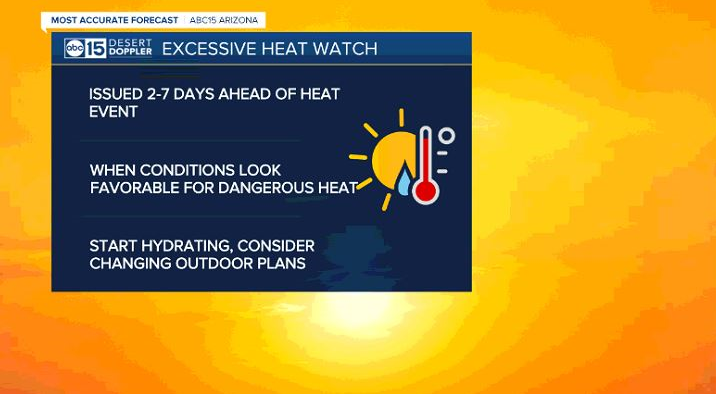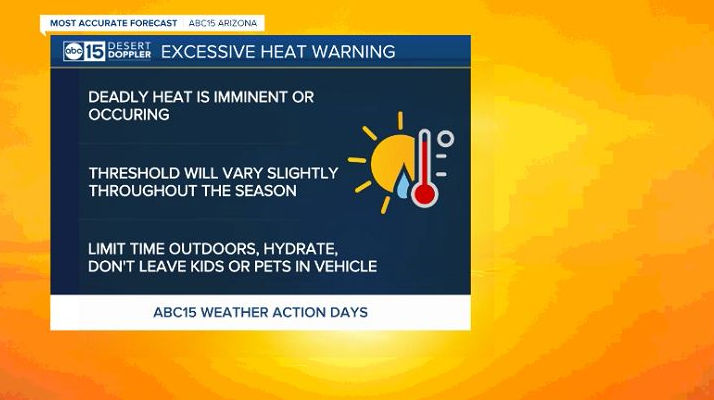PHOENIX — The heat season is here and from now through at least September we are going to be dealing with hot weather that could be dangerous, or even deadly.
Heat is the number one weather-related killer, and 2020 was the deadliest year on record with 520 heat-related deaths in Arizona.
Arizona Heat Awareness Week runs May 10th-14th and is a campaign created by the National Weather Service in partnership with local, county, and state officials to bring awareness to the heat danger we face in our state.
As part of Heat Awareness Week, the ABC15 Impact Earth team wants to make sure you’re prepared for what’s coming our way.
There are several heat alerts that you will see this season.
An Excessive Heat Watch is typically issued two to seven days ahead of potentially dangerous temperatures. When you see an Excessive Heat Watch, it’s time to start pre-hydrating and adjusting your upcoming plans so that you are not caught outside during the hottest hours of the day.

An Excessive Heat Warning is a level up from a watch and is issued when deadly heat is imminent or occurring. Keep in mind that the threshold for these heat warnings will vary slightly throughout the hot months. It depends how acclimated we might be to certain temperatures at different points in the season. For example, you might see an Excessive Heat Warning when we’re looking to reach 105 for the first time but that temperature threshold could go up later in the season, once those low 100s become more common.

Both of these heat alerts are issued based on the heat risk for the day, which can be found here.

When we start to see that risk climb into the High or Very High category, then you know we are expecting unusually hot weather that should not be treated as business as usual.
As temperatures warm up it is important to practice heat safety, especially on heat alert days.
Make sure that you are hydrating by drinking plenty of water. If you are active, it is recommended that you drink four cups of water every hour.
Limit your outdoor activities during those hot days, particularly during the hours of 10 a.m. and 6 p.m., so get those hikes and outdoor workouts done early in the morning.
If you have to work outdoors make sure that you are prepared by having enough water and wearing light-colored, loose-fitting clothing. Make sure to take frequent breaks in the shade or indoors throughout the day, too.
Lastly, remember that the inside of your vehicle heats up way faster and much further than the air outside. So always check your back seat before you lock and walk away from your car, and never leave kids or pets in a vehicle.

While we may live in the desert and triple-digit temperatures are normal during the summer months, that does not make the heat any less dangerous. It is important that you are also able to recognize the signs and symptoms of heat illness, so you can get yourself or others out of danger if needed.
If you are feeling faint or dizzy, sweating excessively, or your skin feels cool or clammy or looks pale, you could be experiencing heat exhaustion. You may also start feeling nauseous or have to vomit, or have a rapid, weak pulse or muscle cramps. If you or someone else is experiencing these symptoms, it is time to get to a cooler place and start drinking water. It is recommended that you drink about half a glass of water every 15 minutes. If your symptoms get worse, get help immediately.


Heat exhaustion could lead to heatstroke. If you are feeling nauseous or are vomiting, have a throbbing headache or you are not sweating and have a rapid pulse, are feeling dizzy or confused, then it is time to call 911 as you could be suffering from heatstroke.
Red, hot, dry skin, and a body temperature above 102 degrees are also symptoms of that stroke. Heatstroke could also cause you to lose consciousness.

Remember, most heat deaths in Arizona involve people who have lived here for 20 years or longer. So even if you are local to the Valley, you need to make sure you are taking care of yourself.






